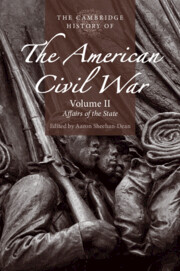Book contents
- The Cambridge History of the American Civil War
- The Cambridge History of the American Civil War
- The Cambridge History of the American Civil War
- Copyright page
- Contents
- Contributors to Volume II
- Note on the Text
- Part I Causes
- Part II Managing the War
- 4 Strategy, Operations, and Tactics
- 5 Union Military Leadership
- 6 Confederate Military Leadership
- 7 Technology and War
- 8 Armies and Discipline
- 9 Financing the War
- 10 Guerrilla Wars
- 11 Occupation
- 12 Atrocities, Retribution, and Laws
- 13 Environmental War
- 14 Civil War Health and Medicine
- 15 Prisoners of War
- Part III The Global War
- Part IV Politics
- Index
- References
13 - Environmental War
from Part II - Managing the War
Published online by Cambridge University Press: 11 October 2019
- The Cambridge History of the American Civil War
- The Cambridge History of the American Civil War
- The Cambridge History of the American Civil War
- Copyright page
- Contents
- Contributors to Volume II
- Note on the Text
- Part I Causes
- Part II Managing the War
- 4 Strategy, Operations, and Tactics
- 5 Union Military Leadership
- 6 Confederate Military Leadership
- 7 Technology and War
- 8 Armies and Discipline
- 9 Financing the War
- 10 Guerrilla Wars
- 11 Occupation
- 12 Atrocities, Retribution, and Laws
- 13 Environmental War
- 14 Civil War Health and Medicine
- 15 Prisoners of War
- Part III The Global War
- Part IV Politics
- Index
- References
Summary
In 2001 noted historian of the South, Jack Temple Kirby conducted a “preliminary environmental impact statement” of the Civil War. He argued that the conflict was an ecological disaster, pointing to issues such as increased incidence of disease, the destruction of cities and towns, the war’s deleterious effects on farms and forests, and the devastation of animal populations, wild and domesticated. He anticipated J. David Hacker’s 2011 recalculation of the war’s death count, suggesting that the war’s “staggering toll of young men – three quarters of a million dead, from combat, disease, exposure, accident – unbalanced the sex ratio for at least a generation, especially in the South, with difficult-to-calculate consequences in terms of labor, business, private life, and the natural world.” Kirby was the first to explicitly raise questions about the war’s environmental costs and he concluded that the war witnessed “unrelenting violence against not only enemy soldiers, but upon the Confederate armies’ very capacities to wage war, violence against civilians, cities, farms, animals, the landscape itself.”
- Type
- Chapter
- Information
- The Cambridge History of the American Civil War , pp. 249 - 267Publisher: Cambridge University PressPrint publication year: 2019



